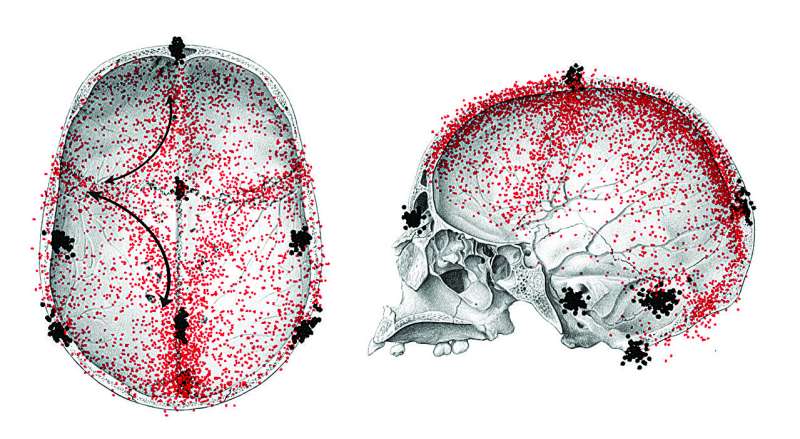This article has been reviewed according to Science X's editorial process and policies. Editors have highlighted the following attributes while ensuring the content's credibility:
fact-checked
proofread
First study of the microvessels connecting the human cranium and brain

Emiliano Bruner, a paleoneurologist at the Centro Nacional de Investigación sobre la Evolución Humana (CENIEH), has just completed the first study to investigate the number and distribution of the microscopic vessels that unite the bones of the cranial vault with the brain. Her results are published in the journal Anatomical Record.
It was suspected that these microvessels are involved in the thermal regulation of the brain, but recently it has been seen that they are also fundamental to its immune response, as they connect the brain with the marrow of the skull bones, where the cells that defend and repair the tissues are produced.
"Their number increases with age up to maturity, but then it appears the count stabilizes. Apparently, in addition, in the sample we analyzed, women present more microvessels than men," observes Bruner.
Bruner's study, conducted in collaboration with Stanislava Eisová, of the National Museum in Prague, reveals that these microvessels and their microchannels are distributed all over the cranial vault, and in particular they correspond spatially with vascular elements that are fundamental to brain drainage: the venous sinuses and the bridging veins. They are rather sparse in the parietal bone, even though this is where the major internal diploic channels of the bone lie.
Craniovascular traits
Certain arteries and veins leave their marks on the bones of the cranium, so that it is possible to investigate their anatomy in fossils or skeletal samples. These "craniovascular traits" usually relate to vessels of great diameter such as the middle meningeal artery and the venous sinuses. However, the microvessels and their microchannels (or microforamina) that join the internal space within the bones of the vault to the brain, crossing the meningeal barrier, have barely been studied.
Bruner described these microforamina in 2017, in a parietal bone found at the Gran Dolina site in Atapuerca, and dated at 800,000 years old. More recently, they have also been described in Neanderthal fossils.
"These small vessels constitute a new trait of interest for both paleoneurology and paleopathology, and furnish yet one more example of the interplay between anthropology and medicine," says the CENIEH paleoneurologist.
More information: Emiliano Bruner et al, Vascular microforamina and endocranial surface: Normal variation and distribution in adult humans, The Anatomical Record (2024). DOI: 10.1002/ar.25426



















